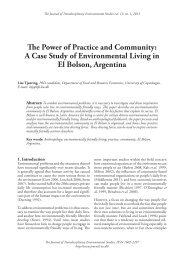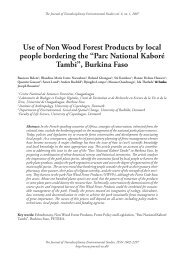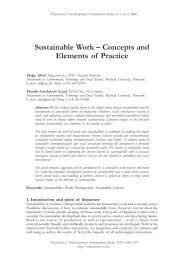Belem et al.: <strong>Use</strong> <strong>of</strong> <strong>Non</strong> <strong>Wood</strong> <strong>Forest</strong> <strong>Products</strong> <strong>by</strong> <strong>local</strong> <strong>people</strong> <strong>bordering</strong> .......Résumé: Dans les pays francophones d’Afrique, les stratégies de conservation, héritées de l’époquecoloniale, excluent les populations riveraines dans l’aménagement et la gestion des ressources forestièresdes parcs nationaux. De nos jours, les lois et législations forestières essaient de concilier la conservationdes ressources et le développement en associant les populations. Par conséquent, des approchesde planification participative en matière d’aménagement forestier sont devenus nécessaires. Un défimajeur dans ces approches est de trouver des stratégies pour intégrer les connaissances <strong>local</strong>es auxconnaissances scientifiques de manière appropriée. Cet article représente une contribution à ce défidans le cas du “Parc National Kaboré Tambi”en proposant une démarche basée sur des enquêtesethnobotaniques et des inventaires de la végétation. L’article analyse l’importance du parc pour lespopulations riveraines et identifie les contraintes auxquelles font face les populations pour accéderaux produits forestiers non ligneux dudit parc. Il analyse la structure de la végétation du parc etestime le degré de régénération de certaines espèces. Les résultats montrent que les populations riverainesconsidèrent le parc comme leur grenier, leur pharmacie, leur lieu de culte, leur pâturage et lasource de la force de leur terroir. Bien que le Code <strong>Forest</strong>ier leur interdit l’accès libre, les populationscontinuent de fréquenter le parc. Environ une centaine de plantes ont été recensées comme pourvoyantdes produits utilisés par les hommes et pour les soins de santé animale. Cependant, le moded’extraction des produits pourrait compromettre la pérennité de certaines espèces. Techniquement,la conservation des espèces à travers leur domestication et l’amélioration des méthodes d’extractiondes produits pourraient être combinées pour une utilisation et une gestion durable des ressources duparc. En fin de compte, le processus vers une intégration de l’écologie, la sylviculture, la législationforestière, l’économie et la décentralisation dans la gestion durable du parc est d’une grande importance.Le succès de ce processus dépendra de tous les acteurs y compris les décideurs, les techniciens,les populations riveraines, les chercheurs et les agences de financement.Mots clés: Ethnobotanique, Produits <strong>Forest</strong>iers <strong>Non</strong> Ligneux, Législation forestière, “Parc National KaboréTambi”, Burkina Faso, PETREA.IntroductionIn Africa, <strong>local</strong> communities depend on forests andplants for <strong>the</strong>ir daily needs including goods andservices. These needs are principally food, medicine,wood, fodder for animals, shade, soil fertilization orreclamation, ornamentation and practices <strong>of</strong> ritualsand customs. Therefore, to limit <strong>the</strong> possibilities<strong>of</strong> exploitation <strong>of</strong> <strong>the</strong>se products, ei<strong>the</strong>r througha restriction <strong>of</strong> access or through a reduction <strong>of</strong><strong>the</strong>ir availability will have a negative impact on <strong>the</strong>wellbeing <strong>of</strong> <strong>the</strong> communities (IIED, 2003; Dahlberg,2005). For most <strong>of</strong> <strong>the</strong> poor <strong>people</strong>, naturalresources and trees are tangible assets (Chambers etal., 1991, Chambers, 1995). Even if forest resourcesare available, <strong>the</strong> competition in relation to <strong>the</strong>irexploitation <strong>of</strong>ten creates conflicts (Gregersen etal., 1995). This is not a new phenomenon, but with<strong>the</strong> undergoing globalisation, democratization anddecentralization <strong>of</strong> natural resource management inAfrica, it has become a critical issue for policy makers,technicians and researchers (Dahlberg, 2005).Classified forests and national parks in <strong>the</strong> Sahelrepresent particular situations in which <strong>local</strong> <strong>people</strong>and forest administration are in perpetual conflictfor <strong>the</strong> access and <strong>the</strong> control <strong>of</strong> <strong>the</strong> resources(IIED, 2003). No one denies <strong>the</strong> fact that forestreserves must be protected for <strong>the</strong> benefit <strong>of</strong> presentand future generations, but <strong>the</strong> ways in which thisprotection should be assured are open to debate(Dahlberg, 2005). Until some 10-15 years ago,forests classification in French speaking WesternAfrica was governed <strong>by</strong> <strong>the</strong> decree <strong>of</strong> July 04, 1935(République de Côte d’Ivoire, 1949). According tothis decree, forest classification has <strong>the</strong> aim to purgeall or a part <strong>of</strong> lands and forest from human use.Since <strong>local</strong> communities are seen as a threat to <strong>the</strong>environment, <strong>the</strong> location <strong>of</strong> villages close to <strong>the</strong>classified forests should not be allowed if it couldbe avoided, (Foury, 1948). After Independence (in1960), forest codes <strong>of</strong> <strong>the</strong> new states took over <strong>the</strong>principles <strong>of</strong> <strong>the</strong> 1935 Decree, establishing forests as<strong>the</strong> property <strong>of</strong> <strong>the</strong> state (Bertrand, 1991).Until recently, <strong>the</strong> importance <strong>of</strong> <strong>Non</strong> <strong>Wood</strong> <strong>Forest</strong><strong>Products</strong> (NWFPs) for <strong>local</strong> <strong>people</strong> seems to be ignoredso that <strong>the</strong> access to national parks for NWFPs
The Journal <strong>of</strong> Transdisciplinary Environmental Studies (TES)harvesting is subject to strict restrictions. Practiceis far from <strong>the</strong>ory, and forest administration hasgreat difficulties to prevent <strong>the</strong> use <strong>of</strong> <strong>the</strong> protectedzones resources, especially when <strong>the</strong> <strong>bordering</strong> villagersare highly dependent on <strong>the</strong>se resources thatcan only be found in <strong>the</strong> protected areas. It is <strong>the</strong>case <strong>of</strong> “Parc National Kaboré Tambi” at Nobéré inBurkina Faso.Nowadays, <strong>the</strong> necessity to conciliate natural resourceconservation with social issues is more andmore recognized (Lanly, 1992; Ribot, 1999; Kjaer &Nathan, 2000). In this respect, nearly all programson natural forests and reserves management <strong>of</strong>Burkina Faso include NWFPs promotion and valuationfor <strong>the</strong> benefit <strong>of</strong> <strong>local</strong> <strong>people</strong> when possible.NWFPs valuation is a component <strong>of</strong> <strong>the</strong> currentRural Development Strategy <strong>by</strong> 2005 (Burkina Faso,2003), <strong>the</strong> <strong>Forest</strong> Resources Management Framework(Ministère de l’Environnement et du Cadrede Vie, 2004) and <strong>the</strong> current Strategic PovertyReduction Framework (Ministère de l’Economie etdu Développement, 2002). Understanding humanpreference on plant products and assessment <strong>of</strong><strong>the</strong> pattern <strong>of</strong> extraction can contribute to a betterunderstanding <strong>of</strong> <strong>the</strong> scope and nature <strong>of</strong> problemsfaced <strong>by</strong> <strong>local</strong> <strong>people</strong> relying on plants for <strong>the</strong>y dailylife (Bognounou, 1996; Lykke, 1998; Cunningham,2001; Madsen, 2004; Lykke et al., 2004; Kristensenet al., 2004).In <strong>the</strong> case <strong>of</strong> tropical forests, <strong>the</strong> way in which <strong>local</strong><strong>people</strong> needs must be integrated in <strong>the</strong> managementprocess has been much debated over <strong>the</strong> years (Sheil,2006). Concerning <strong>the</strong> “Parc National KaboréTambi”, earlier studies were limited to <strong>the</strong> description<strong>of</strong> <strong>the</strong> park focussing ei<strong>the</strong>r on wild animalsor on plants (Toni, 1991; Naturama, 1998 2003).Studies which integrate natural and social sciencesaiming to understand <strong>the</strong> human - plants interactionin <strong>the</strong> context <strong>of</strong> <strong>the</strong> park are lacking. Sustainablemanagement <strong>of</strong> <strong>the</strong> park encompasses good regulationgoverning <strong>the</strong> use <strong>of</strong> <strong>the</strong> plant resources, betteridentification <strong>of</strong> <strong>the</strong> NWFPs collected in <strong>the</strong> park,good harvesting <strong>of</strong> <strong>the</strong> products and better plantspecies regeneration strategies and techniques.In this paper we present results from a study aimedat examining <strong>the</strong> use <strong>of</strong> NWFPs <strong>by</strong> <strong>bordering</strong><strong>people</strong> <strong>of</strong> <strong>the</strong> “Parc National Kaboré Tambi”. Theanalysis moves away from simple plant inventories,and instead examines <strong>the</strong> complexity <strong>of</strong> <strong>the</strong> relationbetween <strong>local</strong> <strong>people</strong> and <strong>the</strong> park in terms <strong>of</strong>NWFPs used in traditional and modern legislationcontexts.Specifically, our goals were to:• analyse <strong>the</strong> importance <strong>of</strong> <strong>the</strong> park for <strong>local</strong> <strong>people</strong>through <strong>the</strong> determination <strong>of</strong> NWFPs collectedand source species including <strong>the</strong> methods <strong>of</strong> extraction<strong>of</strong> <strong>the</strong> products;• identify <strong>the</strong> constraints faced <strong>by</strong> <strong>local</strong> <strong>people</strong> toharvest <strong>the</strong> NWFPs in <strong>the</strong> park;• analyse <strong>the</strong> park vegetation structure and assess<strong>the</strong> regeneration <strong>of</strong> <strong>the</strong> main useful species.We will <strong>the</strong>n discuss how to ensure sustainable harvest<strong>of</strong> NWFPs in <strong>the</strong> park and propose method <strong>of</strong>propagation for each selected plant species.This study took place within <strong>the</strong> framework <strong>of</strong> amultidisciplinary study carried out in <strong>the</strong> PeopleTree and Agriculture Africa (PETREA) programmein Burkina Faso from 2001 to 2005. This researchprogramme focuses on how trees and o<strong>the</strong>r woodyspecies can be brought into wider use <strong>by</strong> rural <strong>people</strong>in Africa. Identification <strong>of</strong> <strong>people</strong>'s needs and priorities,<strong>the</strong> development <strong>of</strong> <strong>local</strong>ly adapted techniquesand strategies for domestication, management anduse <strong>of</strong> useful plant species in co-operation with <strong>local</strong><strong>people</strong> were planned in <strong>the</strong> programme (Nathan,2002). Nobéré village territory has been selectedto conduct <strong>the</strong> PETREA research programme. It ishoped that <strong>the</strong> experiences described in <strong>the</strong> articleand recommendations presented will be useful forresearchers, rural development agents includingforesters who support <strong>the</strong> equitable access to plantresources in protected areas.The article is organised in <strong>the</strong> following way. First,a description <strong>of</strong> <strong>the</strong> study site is given, followed <strong>by</strong>an introduction <strong>of</strong> <strong>the</strong> methodologies used for <strong>the</strong>ethnobotanical surveys and <strong>the</strong> botanical inventoriesrespectively. Following results including NWFPsharvested in <strong>the</strong> park, source species and methods <strong>of</strong>harvesting are presented. The findings are analysedwith respect to vegetation structure, species regenerationand NWFPs harvest constraints. In <strong>the</strong> followingsection, <strong>the</strong> validity and reliability <strong>of</strong> <strong>the</strong> data are discussed,some possible interpretations <strong>of</strong> <strong>the</strong> findingssuggested, and some reflections are made as to whatlessons can be learned for conservation and develop-






